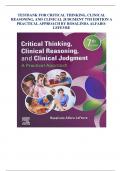TESTBANK FOR CRITICAL THINKING, CLINICAL
REASONING, AND CLINICAL JUDGMENT 7TH EDITION A
PRACTICAL APPROACH BY ROSALINDA ALFARO-
LEFEVRE
, CH 1. What are Critical Thinking, Clinical Reasoning, and Clinical Judgment?
MULTIPLE CHOICE
1.Identify the choice that best completes the statement or answers the question.
1. Which of the following characteristics do the various definitions of critical thinking have in
common? Critical thinking
1)
Requires reasoned thought
2)
Asks the questions why? or how?
3)
Is a hierarchical process
4)
Demands specialized thinking skills
RIGHT CHOICE:- 1
Elaboration:->>>The definitions listed in the text as well as definitions in Box 2 -1 state that
critical thinking requires reasoning or reasoned thinking. Critical thinking is neither linear nor
hierarchical. That means that the steps involved in critical thinking are not necessarily
sequential, where mastery of one step is necessary to proceed to the next. Critical thinking is a
purposeful, dynamic, analytic process that contributes to reasoned decisions and sound
contextual judgments.
POINTS: 1DIFF: Moderate high-level question, answer not stated verbatim
KEY: Nursing process: N/A | Client need: SECE | Cognitive level: Analysis
2. A few medical caretakers on a unit have proposed to the medical caretaker manager that the
process for documenting care on the unit be changed. They have described a completely new system.
Why is it important for the medical caretaker manager to have a critical attitude? It will help the
manager to
1)
Consider all the possible advantages and disadvantages
2)
Maintain an open mind about the proposed change
3)
Apply the nursing process to the situation
4)
Make a decision based on past experience with documentation
RIGHT CHOICE:- 2
Elaboration:->>>A critical attitude enables the person to think fairly and keep an open mind.
POINTS: 1 DIFF: ModerateKEY: Nursing process: N/A | Client need: SECE | Cognitive level:
Comprehension
, 3. The medical caretaker has just been assigned to the clinical care of a newly admitted hospital
client. To know how to best care for the hospital client, the medical caretaker uses the nursing process.
Which step would the medical caretaker probably do first?
1)
Assessment
2)
Diagnosis
3)
Plan outcomes
4)
Plan interventions
RIGHT
CHOICE:- 1
Elaboration:->>>Assessment is the first step of the nursing process. The nursing diagnosis is
derived from the data gathered during assessment, outcomes from the diagnosis, and interventions
from the outcomes. POINTS: 1DIFF: Easy
KEY: Nursing process: Assessment | Client need: SECE | Cognitive level: Application
4. Which of the following is an example of theoretical knowledge? 1)
A medical caretaker uses sterile technique to
catheterize a hospital client. 2)
Room air has an oxygen concentration of 21%.
3)
Glucose monitoring machines should be calibrated daily.
4)
An irregular apical heart rate should be compared with the radial pulse.
RIGHT CHOICE:- 2
Elaboration:->>>Theoretical knowledge consists of research findings, facts, principles, and
theories. The oxygenconcentration of room air is a scientific fact. The others are examples of
practical knowledgewhat to do and how to do it.
POINTS: 1DIFF: Moderate; high-level question, answer not stated verbatim
KEY: Nursing process: N/A | Client need: SECE | Cognitive level: Application
5. Which of the following is an example of practical knowledge? (Assume all are true.)
1)The tricuspid valve is between the right atrium and ventricle of the heart.
2)
The pancreas does not produce enough insulin in type 1 diabetes.
3)
When assessing the abdomen, you should auscultate before palpating.
4)
Research shows pain medication given intravenously acts faster than by other routes.
RIGHT CHOICE:- 3
, Elaboration:->>>Practical knowledge is knowing what to do and how to do it, such as how to
do an assessment. The others are examples of theoretical knowledge, anatomy (tricuspid valve),
fact (type 1 diabetes), and research (IV pain medication).
POINTS: 1DIFF: Moderate high-level question, answer not stated verbatim
KEY: Nursing process: N/A | Client need: SECE | Cognitive level: Application
6. Which of the following is an example of self-knowledge? The medical caretaker thinks, I
know that I 1)
Should take the clients apical pulse for 1 minute before giving digoxin
2)
Should follow the clients wishes even though it is not what I would want
3)
Have religious beliefs that may make it difficult to take care of some clients
4)
Need to honor the clients request not to discuss his health concern with the family
RIGHT CHOICE:- 3
Elaboration:->>>Self-knowledge is being aware of your religious and cultural beliefs and
values. Taking the pulse is an example of practical knowledge. Following client wishes and
honoring client requests are examples of ethical knowledge.
POINTS: 1DIFifficult; high-level question, answer not stated verbatim | V1, high-level
question, answer not stated verbatim
KEY: Nursing process: N/A | Client need: SECE | Cognitive level: Application
7. Which of the following is the most important reason for medical caretakers to be critical thinkers? 1)
Medical caretakers need to follow policies and
procedures. 2)
Medical caretakers work with other healthcare team
members. 3)
Medical caretakers care for clients who have multiple health
problems. 4)
Medical caretakers have to be flexible and work variable
schedules.
RIGHT CHOICE:- 3
Elaboration:->>>Critical thinking is essential for client care, particularly when the care is
complex, involving numerous health issues. Following policies and procedures does not necessarily
require criticalthinking, and working with others or being flexible and working different schedules
do not necessarily require critical thinking.
POINTS: 1DIFF: Moderate; high-level question, answer not stated verbatim
KEY: Nursing process: N/A | Client need: SECE | Cognitive level: Application
8. The medical caretaker administering pain medication every 4 hours is an example of which
aspect of hospital client care?
1)
Assessment data
2)
Nursing diagnosis




